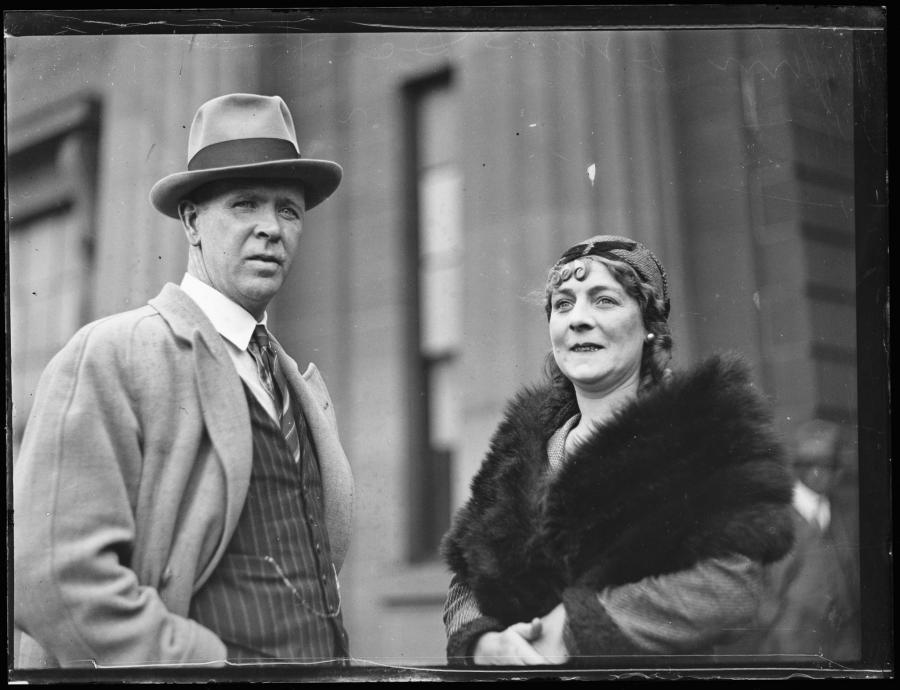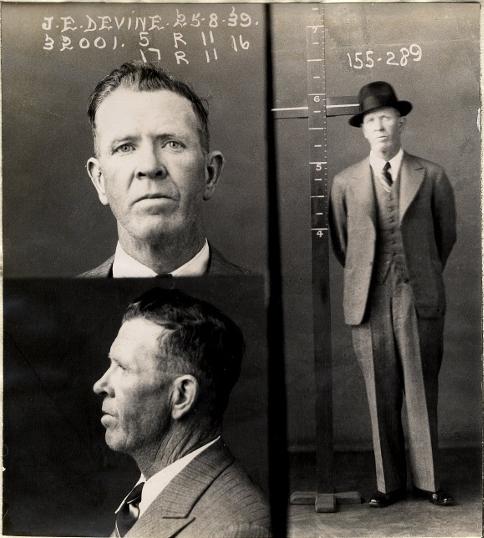Tilly Devine: a war bride of ill repute

James and Matilda (Tilly) Devine, 1930, Sydney. Photo credit: Fairfax photo - supplied by Hachette.
Where there is war, there is love. Almost 13,000 Australian soldiers who fought in the First World War married during their years of service, mostly to English women they met while on leave or during training stints in country.
The Aussie soldiers were an attractive prospect: comparatively well-paid, lively and free-spirited, they offered an escape from bleak surroundings for many young women. Official war historian Charles Bean noted in his diary on 31 January 1916, during a break in London, that girls “are simply throwing themselves at our mens’ heads” – but not all matches, or all girls, were suitable.
He recounted the following:
Jack tells me that quite a few of our men have been marrying English girls. These marriages are rather lightly undertaken in some cases, I fancy. One of Jack’s men in the 3rd Battalion – a most stolid, dry old bone of a chap ... came back to the office the other day and after much scratching of his head, he blurted out that he too had been married in the interval. “Quite a nice girl too,” he said, half to himself, reflectively, fingering the back of his head. The next week he turned up on sick parade and was seen by Sgt Wolseley, Jack’s little right-hand man. He confessed in the same dry style that he was suffering from a dose of gonorrhoea. “Why, who gave it to you?” asked little Wolseley. “Not your wife, surely?” “Well – no – as a matter of fact, it was the chief bridesmaid,” said the bashful A -- -- mournfully. These Australians!
Tilly Devine was a war bride with a less than reputable past, and an even more notorious future ahead of her. Born Matilda Twiss in London in 1900, she was working as a prostitute on the city’s streets when she married Sapper James Devine, a former Queensland shearer, in 1917.
Jim Devine was quite possibly the AIF’s worst soldier: his service record lists dozens of unauthorised absences, periods in detention, and numerous stints in hospital with “VD”– venereal disease. He served briefly in France with the 4th Tunnelling Company, but spent most of the war in English training camps, or AWOL. When the war ended, he faced court martial for his illegal absences, and served a lengthy sentence in England before returning to Australia in October 1919.

Police photographs of Tilly Devine in 1925; she was then sentenced to two years goal for a razor attack on a man. Courtesy of State Records of New South Wales

Police photographs of Jim Devine in 1939. Courtesy of State Records of New South Wales
Tilly arrived in Sydney in January 1920 aboard the “bride” ship, Waimana. The couple quickly established themselves as part of the city’s seedy underbelly; Tilly once again began working as a prostitute, and Jim as her protector and chauffeur. She was arrested often: before she had turned 25 she had almost 80 convictions for prostitution, offensive behaviour and indecent language. In 1925, she was imprisoned for two years after slashing a man with a razor. She gained a reputation as the “Worst Woman in Sydney” and “The Queen of the Night”.
By the late 1920s Jim Devine had further enmeshed himself in the criminal underworld, with dealings in drugs, “sly grog” and attacks on rival gangs. Tilly moved on from being a prostitute to becoming a madam, and more charges followed for her illegal activities. Despite this, she was a very successful businesswoman, employing bodyguards and acquiring properties. By the time the Second World War broke out, Tilly had attained a more affectionate reputation among Sydneysiders and was known for her collection of diamond rings, her opulent dress style and her lavish parties.
Tilly’s relationship with Jim had become increasingly violent and, no longer needing his protection, she divorced him in August 1943 on the grounds of cruelty. It was a boom time for her, as vast numbers of local and Allied servicemen passing through Sydney fed a demand for brothel services. Tilly contributed generously to the war effort and in 1945 she married again, to a seaman named Eric Parsons.
When the war ended the best of Tilly’s years were behind her, but she remained a prominent and criminally active figure and was brought before the court numerous times. She travelled to London in 1953 to see the Coronation procession, and operated her brothel until 1968.
Tilly Devine died in a Sydney hospital on 24 November 1970. She was survived by a son whom she had adopted during her second marriage. Her two children to Jim Devine had predeceased her.
Tilly would undoubtedly be delighted to know that her story lives on, with the current Nine Network television series Underbelly razor based on her and Jim’s notorious activities. The contribution made to Australian society by so many other First World War brides was, of course, of far greater moral and social value, and today there are tens of thousands of their descendants among us.
Sources and further reading
Allen, Judith, 'Devine, Matilda Mary (Tilly) (1900–1970)', Australian Dictionary of Biography, National Centre of Biography, Australian National University, http://adb.anu.edu.au/biography/devine-matilda-mary-tilly-5970/text10185
Fifty Australians exhibition, Australian War Memorial, /visit/exhibitions/exhibitions-past/fiftyaustralians/15
C.E.W. Bean, AWM38 Official History, 1914–18 War: Records of C.E.W. Bean, Official Historian.